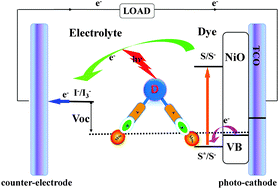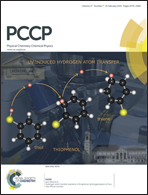Theoretical studies on POM-based organic–inorganic hybrids containing double D–A1–π–A2 chains for high-performance p-type, dye-sensitized solar cells (DSSCs)†
Abstract
Polyoxometalate (POM)-based organic–inorganic hybrid systems II1–II7 are designed as p-type dyes containing double D–A1–π–A2 chains. The A1 spacers are thiophene, 1,2,3-triazole, 1,3,4-oxadlazole, thienothiadiazole units or their combinations and the A2 spacer is hexamolybdate. The electronic structures, absorption spectra, and electronic transition characteristics of systems were systematically studied on the basis of density functional theory (DFT) and time-dependent DFT (TDDFT). The highest occupied molecular orbital (HOMO) levels of systems II1–II7 were below the valence bond (VB) of NiO and the lowest unoccupied molecular orbital (LUMO) levels of studied systems were higher than the I2/I3− redox level, which benefit hole injection and dye regeneration. The HOMOs of systems II1–II4 were predominantly delocalized over the organic groups and Mo![[triple bond, length as m-dash]](https://www.rsc.org/images/entities/char_e002.gif) N, which are more helpful to hole injection than systems II5–II7. Introduction of thienothiadiazole units is an effective way to improve the light absorption ability of dyes, and inserting thiophene and 1,2,3-triazole as A1 spacers can increase the efficiency of dye in dye-sensitized solar cells (DSSC).
N, which are more helpful to hole injection than systems II5–II7. Introduction of thienothiadiazole units is an effective way to improve the light absorption ability of dyes, and inserting thiophene and 1,2,3-triazole as A1 spacers can increase the efficiency of dye in dye-sensitized solar cells (DSSC).


 Please wait while we load your content...
Please wait while we load your content...